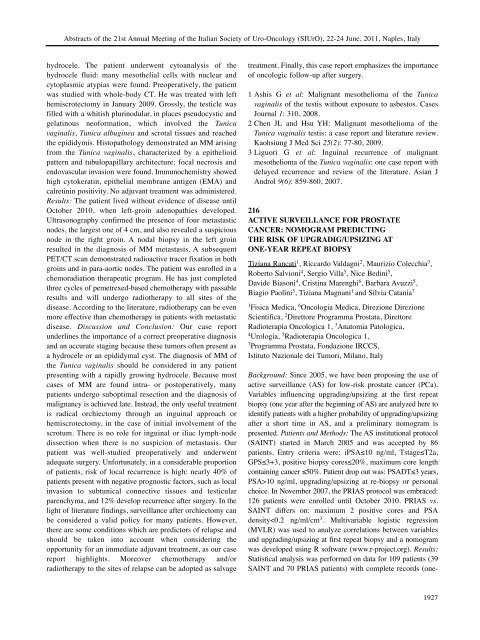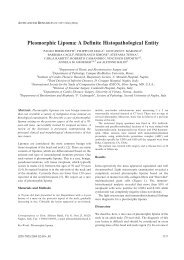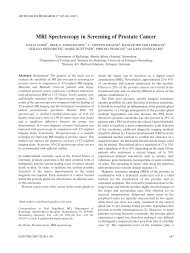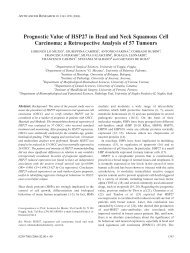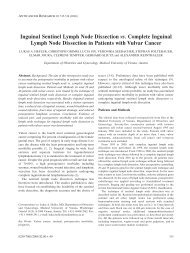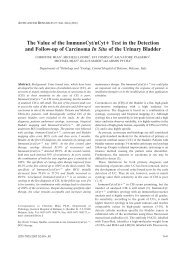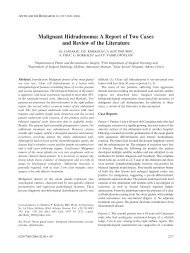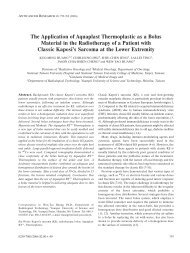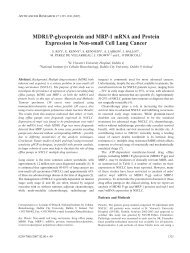ABSTRACTS OF THE 21st ANNUAL MEETING OF THE ITALIAN ...
ABSTRACTS OF THE 21st ANNUAL MEETING OF THE ITALIAN ...
ABSTRACTS OF THE 21st ANNUAL MEETING OF THE ITALIAN ...
Create successful ePaper yourself
Turn your PDF publications into a flip-book with our unique Google optimized e-Paper software.
Abstracts of the <strong>21st</strong> Annual Meeting of the Italian Society of Uro-Oncology (SIUrO), 22-24 June, 2011, Naples, Italy<br />
hydrocele. The patient underwent cytoanalysis of the<br />
hydrocele fluid: many mesothelial cells with nuclear and<br />
cytoplasmic atypias were found. Preoperatively, the patient<br />
was studied with whole-body CT. He was treated with left<br />
hemiscrotectomy in January 2009. Grossly, the testicle was<br />
filled with a whitish plurinodular, in places pseudocystic and<br />
gelatinous neoformation, which involved the Tunica<br />
vaginalis, Tunica albuginea and scrotal tissues and reached<br />
the epididymis. Histopathology demonstrated an MM arising<br />
from the Tunica vaginalis, characterized by a epithelioid<br />
pattern and tubulopapillary architecture; focal necrosis and<br />
endovascular invasion were found. Immunochemistry showed<br />
high cytokeratin, epithelial membrane antigen (EMA) and<br />
calretinin positivity. No adjuvant treatment was administered.<br />
Results: The patient lived without evidence of disease until<br />
October 2010, when left-groin adenopathies developed.<br />
Ultrasonography confirmed the presence of four metastastic<br />
nodes, the largest one of 4 cm, and also revealed a suspicious<br />
node in the right groin. A nodal biopsy in the left groin<br />
resulted in the diagnosis of MM metastasis. A subsequent<br />
PET/CT scan demonstrated radioactive tracer fixation in both<br />
groins and in para-aortic nodes. The patient was enrolled in a<br />
chemoradiation therapeutic program. He has just completed<br />
three cycles of pemetrexed-based chemotherapy with passable<br />
results and will undergo radiotherapy to all sites of the<br />
disease. According to the literature, radiotherapy can be even<br />
more effective than chemotherapy in patients with metastatic<br />
disease. Discussion and Conclusion: Our case report<br />
underlines the importance of a correct preoperative diagnosis<br />
and an accurate staging because these tumors often present as<br />
a hydrocele or an epididymal cyst. The diagnosis of MM of<br />
the Tunica vaginalis should be considered in any patient<br />
presenting with a rapidly growing hydrocele. Because most<br />
cases of MM are found intra- or postoperatively, many<br />
patients undergo suboptimal resection and the diagnosis of<br />
malignancy is achieved late. Instead, the only useful treatment<br />
is radical orchiectomy through an inguinal approach or<br />
hemiscrotectomy, in the case of initial involvement of the<br />
scrotum. There is no role for inguinal or iliac lymph-node<br />
dissection when there is no suspicion of metastasis. Our<br />
patient was well-studied preoperatively and underwent<br />
adequate surgery. Unfortunately, in a considerable proportion<br />
of patients, risk of local recurrence is high: nearly 40% of<br />
patients present with negative prognostic factors, such as local<br />
invasion to subtunical connective tissues and testicular<br />
parenchyma, and 12% develop recurrence after surgery. In the<br />
light of literature findings, surveillance after orchiectomy can<br />
be considered a valid policy for many patients. However,<br />
there are some conditions which are predictors of relapse and<br />
should be taken into account when considering the<br />
opportunity for an immediate adjuvant treatment, as our case<br />
report highlights. Moreover chemotherapy and/or<br />
radiotherapy to the sites of relapse can be adopted as salvage<br />
treatment. Finally, this case report emphasizes the importance<br />
of oncologic follow-up after surgery.<br />
1 Ashis G et al: Malignant mesothelioma of the Tunica<br />
vaginalis of the testis without exposure to asbestos. Cases<br />
Journal 1: 310, 2008.<br />
2 Chen JL and Hsu YH: Malignant mesothelioma of the<br />
Tunica vaginalis testis: a case report and literature review.<br />
Kaohsiung J Med Sci 25(2): 77-80, 2009.<br />
3 Liguori G et al: Inguinal recurrence of malignant<br />
mesothelioma of the Tunica vaginalis: one case report with<br />
delayed recurrence and review of the literature. Asian J<br />
Androl 9(6): 859-860, 2007.<br />
216<br />
ACTIVE SURVEILLANCE FOR PROSTATE<br />
CANCER: NOMOGRAM PREDICTING<br />
<strong>THE</strong> RISK <strong>OF</strong> UPGRADIG/UPSIZING AT<br />
ONE-YEAR REPEAT BIOPSY<br />
Tiziana Rancati1 , Riccardo Valdagni2 , Maurizio Colecchia3 ,<br />
Roberto Salvioni4 , Sergio Villa5 , Nice Bedini5 ,<br />
Davide Biasoni4 , Cristina Marenghi6 , Barbara Avuzzi5 ,<br />
Biagio Paolini3 , Tiziana Magnani1 and Silvia Catania7 1Fisica Medica, 6Oncologia Medica, Direzione Direzione<br />
Scientifica, 2Direttore Programma Prostata, Direttore<br />
Radioterapia Oncologica 1, 3Anatomia Patologica,<br />
4Urologia, 5Radioterapia Oncologica 1,<br />
7Programma Prostata, Fondazione IRCCS,<br />
Istituto Nazionale dei Tumori, Milano, Italy<br />
Background: Since 2005, we have been proposing the use of<br />
active surveillance (AS) for low-risk prostate cancer (PCa).<br />
Variables influencing upgrading/upsizing at the first repeat<br />
biopsy (one year after the beginning of AS) are analyzed here to<br />
identify patients with a higher probability of upgrading/upsizing<br />
after a short time in AS, and a preliminary nomogram is<br />
presented. Patients and Methods: The AS institutional protocol<br />
(SAINT) started in March 2005 and was accepted by 86<br />
patients. Entry criteria were: iPSA≤10 ng/ml, Tstage≤T2a,<br />
GPS≤3+3, positive biopsy cores≤20%, maximum core length<br />
containing cancer ≤50%. Patient drop out was: PSADT≤3 years,<br />
PSA>10 ng/ml, upgrading/upsizing at re-biopsy or personal<br />
choice. In November 2007, the PRIAS protocol was embraced:<br />
126 patients were enrolled until October 2010. PRIAS vs.<br />
SAINT differs on: maximum 2 positive cores and PSA<br />
density


